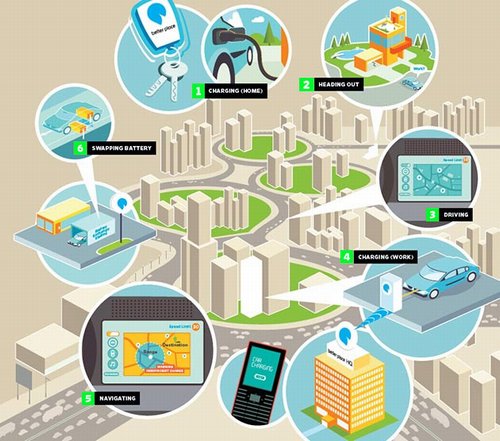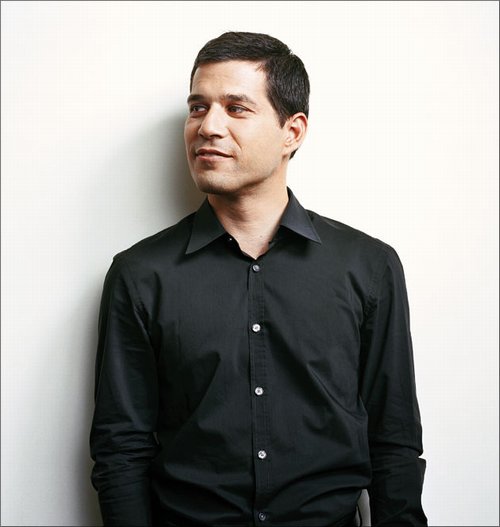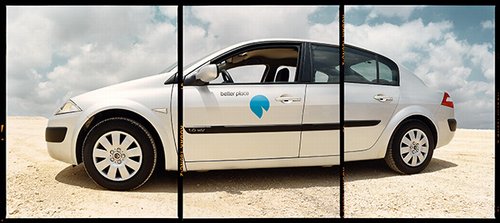With the aura of an evangelist, Israel’s Shai Agassi is moving full steam ahead to revolutionize the electric car market, with Project Better Place. Essentially borrowing the model from the cellular market, Agassi plans to create a new electric car paradigm, where you switch batteries and pay for the lease of the battery (like minutes on the phone), rather than the device itself.
Earlier, in August, he was featured in Wired magazine (read the long article Shai Agassi’s Audacious Plan to Put Electric Cars on the Road here), which we’ve just got around to posting about now.
Now I’ve posted some of my thoughts about the electric car on the The Huffington Post, later picked up by the Green Autoblog. While everyone is going gaga over Agassi, I think it’s wise for a few critics out there to voice their concerns. It seems that Agassi’s plan is an inevitability, so I hope my concerns might help the company build their project with a little more of the environment in mind.
A few questions:
Do we really more and cheaper cars on the road?
What energy source is fueling the battery power packs in Agassi’s cars?
Do we really have the real estate in Israel to create new battery-swapping stations?
The cart before the horse
I think that the electric car project, though admirable in its vision and ability to convince opinion leaders to adopt it in Israel, Denmark, and elsewhere, I think it’s a little bit like putting the cart before the horse. We need the world to band together to create serious and sound renewable energy sources first. If we don’t, and sorry to be a doomsday prophet, I think electric cars will be irrelevant (see the post about a site Green Prophet is sponsoring: 100 Months).
The Wired illustration of how Agassi’s electric car will work:

::Jewlicious
(image credit Wired)
More on Israel’s electric car:
Israel’s Electric Car and Impact on Water Shortage
Shai Agassi’s Electric Car is Coming
Green Smoke and Mirrors: A Voice of Reason on Israel’s Electric Car Hype






Its amazing as it is pollution free and saves environment and it is good if we use solar energy as an addition fuel with batteries.
Its amazing as it is pollution free and saves environment and it is good if we use solar energy as an addition fuel with batteries.
I have a few questions or suggestions for your electric car program that includes millions of “charging stations” spread all across the country which choses to use the concept. Consider the following: install a small 25 horse gas engine connected to a large capacity electric generator that is connected to the bank of batteries powereing the car. The 25 horse engine is programed to start automaticaly when the battery power falls to a recharge point and then turn itself off when the batteries are charged. Therefore, the battery bank will be automatically recharged by the self contained self starting self regulating gasoline engine. The 25 horse engine will, by it’s size, use very little fuel. In fact anytime that the electrice car is in operation it is recharging itself internally as it travels. This means that it will not run out of power, have an unlimited range of travel, and will not need the very expensive “charging stations”. I suggest you test this concept before you decide on the hugely expensive “charging stations”. Also, why not take avantage of each wheels circular movement. Why not have each wheel attached to it’s own generator which as it moves, it sends electric current to the batteries to recharge them. Now, using current to move the wheels generates new current to recharge the batteries.
Shalom Alecheim,
Shai Agassi,
This is prophesy come to pass,i had the same project in high school in nairobi kenya in the year 1987 and i was just in preparation to meet you ,won first prize in designing and electric car…..Now where can i apply myself in your network ….maybe on charging spots and also ,need use the communication carreer knowledge i had in telephony switching work i did for 15 years before i retired …please what is your direct contact by phone or address…i am in Africa and Kenya in East africa,nairobi….when are coming to launch here even on taxis….
Mail Box is
JOEL WAITHAKA
P.O.BOX 15264-00100 G.P.O
NAIROBI,
KENYA,
EAST AFRICA,
AFRICA,
CELL PHONE:+254-721-436589
CELL PHONE :+254-733-757108
e-mail [email protected]
e-mail [email protected]
I personally love Yisrael and i see the annointing in you for the gifts from our king Elohim,the ruach ha kodesh continue giving you emmunah in your nifesh to fullfil your mission and reward is coming…preach brother,please am available in need of anything that i am required to do.
havenu shalom alecheim
If someone develops a photovoltaic recharger for HOME USE then he could use his electric car to drive RIGHT PAST an electric recharging station. I saw a youtube clip of a California man w/a totally Toyota RAV4 electric car doing exactly that. Just because Agassi wants to set up his electric car operation in a certain way doesn’t mean that 3rd party Israelis won’t come up w/WORKAROUNDS!!!
Good Post. Thanks for the info🙂
No idea if the model works as a business. But as a communicating device, it is brilliant. Far too much of the green tech talk out there strays from issues that people can relate to…and as such, it sounds like sci-fi to folks who are not engaged. That is no way to get things done… But if you talk to people about the technologies they use every day (like a mobile phone or ATM) and remind them that these technologies emerged into ubiquity over a very short period of time—well, now you are starting to tear down some of the perceptual barriers that are preventing us from making a bigger investment in green technology in this country. I am not endorsing Better Places model and I don’t know if they will succeed—but I do know that this sort of discussion, one that everyone can relate to, is incredibly valuable in moving the electric car debate forward at a much quickler pace—and as a communications person for an enviro group; wow, that is great to see!
Gotta give the man a hand for trying something.
And on such a scale!
(Personally I think the swap idea has too many challenging variables but who am I?)
One thing for sure is that Israel will get a boost along towards freedom from Oil no matter what!
And there’s a lot of small developing Island countries that could be assisted in a similar manner (if Aid packages are designed to such a goal)
I live on a small tropical island so I hope that he succeeds with something that can be referenced to
Is there any similarity in developing nations for going to electric vehicles verses where developing nations skipped the installation of landlines as the primary communication means and went straight to Wireless?
I’d hope so in the case of China where they are listed lower than Haiti for Car density per pop.
http://www.nationmaster.com/graph/tra_veh_abu-transportation-vehicle-abundance
It would be interesting to see the development happening for them in that direction.
As for the large trucks etc, http://www.go-ev.com/EMIS.html is a great way of assisting where total electric conversion might not be suitable
And what about financial incentives in Israel for those people wanting to convert to electric with their current vehicles? (assuming legal parameters can be set). There’s a whole industry just waiting to happen
I agree that the whole plan is not without its limitations but if there is support for the mans’ schemes he may well succeed and show us all the way out of the energy problems and environmental problems that the world is facing right now.
Hard not to respond to the boatload of inaccuracies in Kent Beuchert’s (aka Kerry Bradshaw) comment but I will refrain.
Just stopped by to let you know Better Place will have some competition in Israel.
http://www.autobloggreen.com/2008/08/25/byd-getting-israeli-partner-to-compete-with-renault-and-better-p/
Shai Agassi has managed to convince the
controlling politicians of several rather
energy-desperate countries (Israel and Denmark)
of the merits of his battery swapping scheme (an
old idea not original with Agassi) as the best
way to avoid petroleum dependencies. There are
severe problems with his arguments :
1) his system won’t come anywhere close to
removing petroleum dependencies – fully 1/3rd
is used for commercial trucking, boats, etc,
which won’t be covered by his system, nor
will any of the petroleum used to make heating oil,
lubricants, etc. This will be true irregardless of
which private transportation technology is adopted.
2) his tiny vehicles will not satisfy the needs
of the driving public;
3) the swapping frequency while on a trip (about every
80 minutes) is needlessly inconvenient;
4) Each highway traveller on a trip in his system requires many
battery packs in reserve every day to meet his mileage
requirements. This greatly increases the number of battery
packs the system and its overall costs. Batteries are one of
the main reasons electric cars are not practical, and his
system makes that deficiency even worse.
The battery packs muct also be located in just the right
spots.
4) Agassi’s economic arguments are only directed at gas powered
vehicles, which are NOT the main competitors his system
must face :
Plug-in hybrids are his main competitors, like the 40 mile
electric ranged Volt, which can accomplish every bit as
much as his much more expensive (trillions for infrastructure),
inconvenient system of tiny vehicles :
For one thing, we can electrify a lot more vehicle types
as plug-ins (e.g. large pickup trucks, vans, etc.) than we
could using swappable battery power drivetrains, which are
severely limited in their power outputs.
And we can easily demonstrate, using DOT commuter trip
statistics, that a 40 mile range plug-in fleet can avoid 94%
of current commuter gasoline requirements (97% if 1/4 of the
workers can recharge at their workplace), and probably more
than 93% overall. That range will likely be 50 miles in the near
future, which would avoid 96% and 98% respectively.
Regardless, it’s clear that any liquid fuel
requirements of a plug-in fleet can be met entirely by ethanol.
Since ethanol is more carbon neutral that typical electrical
power, Agassi’s scheme is inferior in carbon emissions, although,
quite frankly, any differences between the two systems is
insignificant and unimportant : both will achieve far more than
is required.
Agassi has simply not produced a viable, or even defensible,
technology for the electrification of the fleet. The idea of swappable batteries is old and just as harebrained now as it was when it was first suggested decades ago. gassi is basically a con man with some ignorant pidgeons desperate to avoid oil.
And when
batteries become quickly rechargeable, Agassi’s entire trillion
dollar system becomes instantly obsolete, whereas the current system we have would simply find gas stations swapping out gas pumps for charging posts as the demand irrevocably shifts from gasoline to
electricity. And since a very large portion of the electricity
used to fill those batteries will come from household outlets,
a great many of the gas stations today will disappear, making
the transportation fueling system even more efficient.